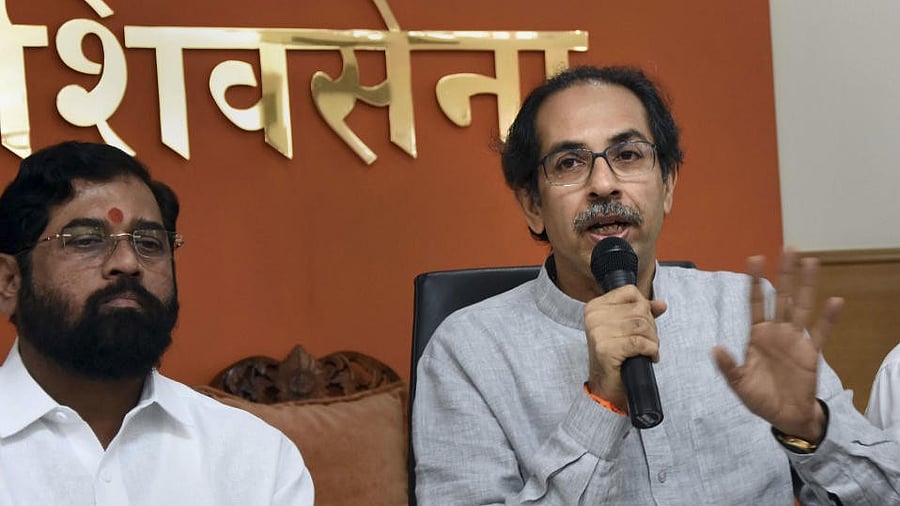
Maharashtra Chief Minister Eknath Shinde and former Chief Minister Uddhav Thackeray
Credit: PTI File Photo
Maharashtra politics continues to be on the boil with a major development set to take place on January 10.
With the verdict by the Maharashtra Assembly Speaker on the cross-petitions by Shiv Sena factions seeking disqualification of each other's MLAs expected on Wednesday, here is a summary of how the saga has unfolded so far.
To understand the Sena split of 2022, it is crucial to know the roots of the party and its core ideology.
Roots of Shiv Sena
As Mumbai, then Bombay, grew as a city, migrants from all over India started to pour into the city. Based on the anti-migrant sentiments, a famous cartoonist Balasaheb Thackeray founded, in June 1966, a party called Shiv Sena.
Shiv Sena, founded as a right wing and pro-Marathi party, made Thackeray a stalwart in Maharashtra politics. Gradually, the party embraced the Hindutva ideology and thus, its proximity to BJP grew. Shiv Sena became a staunch BJP ally and remained a part of the NDA till 2019.
Uddhav's leap
In 2019, Maharashtra went for Assembly polls with Shiv Sena, a part of the BJP-led NDA, up against the Congress-NCP led UPA.
The BJP-Shiv Sena-led NDA easily crossed the majority mark in the 288-member assembly but a tussle regarding the chief minister post spread uneasiness in the alliance. Sena, with just 56 seats, wanted its leader and Balasaheb Thackeray’s political heir Uddhav Thckeray on Maharashtra’s top post, while BJP with 105 seats, could not adjust this demand and wanted its CM face Devendra Fadnavis at the helm of the assembly.
Eventually, Sena left the NDA ending a long-standing partnership between the two saffron parties.
BJP’s loss turned into Congress-NCP’s gain as the Shiv Sena made a massive political somersault landing right into a newly-formed alliance called the Maha Vikas Aghadi (MVA).
By November end of 2019, Maharashtra had an MVA government with Sena’s Udddhav Thackeray on the chief minister’s chair supported by NCP and Congress.
All this political maneuvering looked like bearing fruit but in 2022 another twist awaited Maharashtra politics.
Rise of Shinde
Thackeray’s ideological leap did not sit well with a faction of Shiv Sena. The party had remained a saffron party for so long and the colour stayed on a group that eventually rebelled.
Eknath Shinde was a long-time Sena worker and the then Maharashtra Public Works Department Minister. Shinde largely remained low profile until his turn to attain fame came in mid 2022. Shinde, along with a major chunk of Shiv Sena MLAs left the MVA and shook hands with the BJP. Shinde’s revolt left Thackeray’s faction in what the Supreme Court would later say a "hopeless minority".
Thackeray resigned without facing a floor test and in a surprise move, Shinde was made the chief minister of Maharashtra. With the chief ministership in his hands, Shinde now aimed at the party itself. The new CM claimed the name of the party and the iconic bow and arrow symbol. Both factions filed petitions against each other claiming to be the "real" Shiv Sena.
The "real" Shiv Sena
The case went to the Election Commission of India which ruled in the rebel group’s favour, meaning that the Shinde group was now the "real" Shiv Sena, while Udhhav’s faction had to rename itself and change its symbol.
The cross petitions were then heard in the Supreme Court in May , 2023. Thackeray’s move of not facing the floor test came back to bite him hard as the top court said that his chief ministership could not be restored due to this factor.
The court also gave time till December 31, 2023 and later extended it to January 10, today, to Maharashtra Speaker Rahul Narwekar to decide on the disqualification pleas.
Both the parties can go to the Supreme Court in case they are dissatisfied with the order.